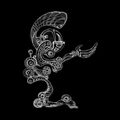Template:Selected anniversaries/July 25: Difference between revisions
No edit summary |
No edit summary |
||
| Line 7: | Line 7: | ||
File:Andreas Libavius.jpg|link=Andreas Libavius (nonfiction)|1616: Physician, alchemist and chemist [[Andreas Libavius (nonfiction)|Andreas Libavius]] dies. He accepted the Paracelsian principle of using occult properties to explain phenomena with no apparent cause, but rejected the conclusion that a thing possessing these properties must have an astral connection to the divine. | File:Andreas Libavius.jpg|link=Andreas Libavius (nonfiction)|1616: Physician, alchemist and chemist [[Andreas Libavius (nonfiction)|Andreas Libavius]] dies. He accepted the Paracelsian principle of using occult properties to explain phenomena with no apparent cause, but rejected the conclusion that a thing possessing these properties must have an astral connection to the divine. | ||
File:Charles Messier.jpg|link=Charles Messier (nonfiction)|1748: Astronomer [[Charles Messier (nonfiction)|Charles Messier]]'s interest in astronomy is stimulated by an annular solar eclipse visible from his hometown. | File:Charles Messier.jpg|link=Charles Messier (nonfiction)|1748: Astronomer [[Charles Messier (nonfiction)|Charles Messier]]'s interest in astronomy is stimulated by an annular solar eclipse visible from his hometown. | ||
Revision as of 05:27, 25 July 2019
1616: Physician, alchemist and chemist Andreas Libavius dies. He accepted the Paracelsian principle of using occult properties to explain phenomena with no apparent cause, but rejected the conclusion that a thing possessing these properties must have an astral connection to the divine.
1748: Astronomer Charles Messier's interest in astronomy is stimulated by an annular solar eclipse visible from his hometown.
1808: Mathematician Johann Benedict Listing born. He will introduce the term "topology" in a famous article published in 1847, having already used the term in correspondence some years earlier.
1837: The first commercial use of an electrical telegraph is successfully demonstrated in London by William Cooke and Charles Wheatstone.
1842: Physician and surgeon Dominique Jean Larrey dies. He was an important innovator in battlefield medicine and triage, and is often considered the first modern military surgeon.
1920: Chemist and X-ray crystallographer Rosalind Franklin born. She will make contributions to the discovery of the molecular structure of DNA (deoxyribonucleic acid).
1963: Mathematician and physicist Nicholas Metropolis publishes new class of Gnomon algorithm functions which he derived using the Monte Carlo method. He will soon use these new functions to detect and prevent crimes against mathematical constants.
2016: Signed first edition of Lend a Hand used in high-energy literature experiment unexpectedly generates "at least a dozen, perhaps as many as fifteen" organic golems.
2017: Dennis Paulson of Mars observes a minute of silence in memory of the Viking 2 orbiter, which was turned off forty-one years ago, after returning almost 16,000 images in about 700–706 orbits around Mars.









